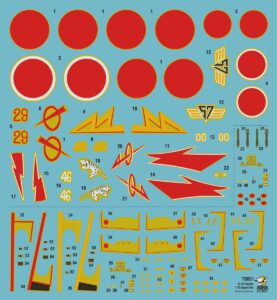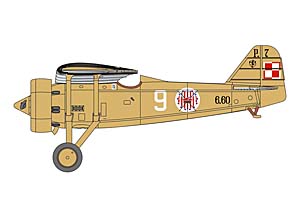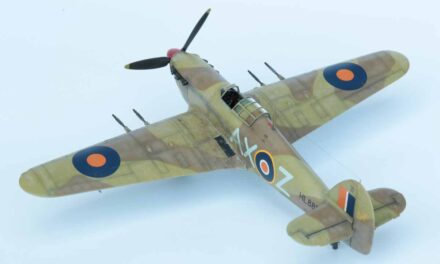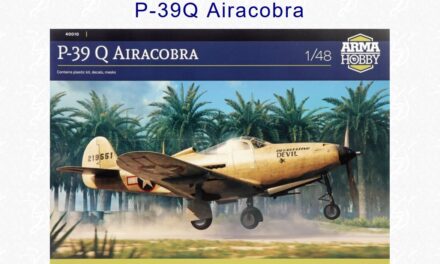From among the six paint schemes offered by ARMA Hobby in its first edition of the Ki-84 model, the hero of today’s piece is distinguished by its complete “nakedness”, that is a total lack of camouflage. We must admit that the beautiful silhouette of the Japanese fighter is exceptionally attractive in the Natural Metal Finish (NMF), which will surely tempt many modellers. Obviously, this finish was not uncommon on Hayates. To the contrary. In addition to the light grey/dark green camouflage applied to some of the aeroplanes, it was a factory standard.
The NMF fighters delivered to combat units were often (due to “circumstances of nature”) covered with camouflage patterns of very different colour and a broad range of designs in situ. However, in the case of training squadrons, and especially those based on the home islands, such a direct necessity did not usually arise (although there were exceptions). Nevertheless, the “Red 29”, which served with 10. Rensei Hikotai (10th Operational Training Squadron), carried out its tasks in its original factory livery.
Markings
The basic element of the markings was of course the Hinomaru in six positions. The “suns” did not have white borders, which was typical for aircraft with lightly coloured surfaces. Equally typical was the black anti-glare strip and the yellow quick identification elements on the wing leading edges. All warning lines on the wings, access panels to the fuel fillers and technical inscriptions were painted in red. The rudder and aileron surfaces (covered with fabric) were normally coloured in a very light grey-green. In order to ensure the proper impregnation of the material, it was coated with a colourless varnish, which was usually enriched with a greenish pigment which facilitated a visual assessment of the correctness of its placement. Sometimes these elements were additionally painted with silver paint, however not in the present case. The large registration number on the engine casing was frequently applied to mark aircraft from training units. The propeller spinner and the propeller itself were factory-painted with the same grey-green protective paint, but in front line units the colour of the spinner would be changed in accordance with individual marking methodologies. The spinner of our Hayate – as well as the emblem of 10. Rensei Hikotai – was probably red. I will return to both these elements later on in the story. Now, however, I would like to take the opportunity of saying a few words about the structure of the Japanese flying training system.
Zawartość pudełka modelu Ki-84 Hayate 1/72 Expert Set – In-Box
Flight Training in the Imperial Japanese Army Air Force (IJAAF) in the Years 1935–45
A modern system of education for the “Imperial Falcons” was developed in the first half of the 1930s. Some corrections were made in the years 1935–37, thus complementing the canon that was to remain in force over successive years. The full, studiously planned process comprised four consecutive stages (or five, according to some sources), and its implementation was entrusted to the Koku Sokambu – the Chief Inspectorate of Military Aviation.
Stage I – NCO Aviation School (Shonei Hikohei Gakko)
This institution received mainly secondary school graduates who aspired to serve in military aviation. For the first two months, they underwent basic military training and were closely observed as regards their psychophysical abilities and skills. This led to an initial aptitude-based division of recruits into two groups: potential flying personnel and potential ground crews. Over the next year, the young trainees broadened their knowledge in accordance with their selected/assigned specialization, however without coming into contact with aeroplanes or flying. Upon the completion of schooling, they received the rank of ensign.
Stage II – Elementary Flying School (Hiko Gakko-Ko)
Here, the freshly-promoted NCOs would start flying on training biplanes. The curriculum comprised a total of approximately 90–100 hours flight time, a quarter of which was completed in the company of an instructor and the rest individually. The course ended with an intensive two-month period of training and a division into fighter, bomber, and reconnaissance pilots. Graduates left the school with the rank of second lieutenant.
Stage III – Secondary Flying School (Hiko Gakko-Otsu)
Training at this school lasted about 4 months and was aimed both at building on existing skills and adjusting piloting habits to aircraft of a specific type (fighter, bomber, etc.). The basic program comprised 120 hours of individual flight time.
Stage IV – Operational Training Facility (Renshuki Gakko)
During this stage, the pilots learned to fly aircraft similar to those that were currently used by front line units. Initially, these were mainly Ki-27s and Ki-43s, and in later years Ki-44s, Ki-61s, Ki-84s and Ki-100s. The first two months were devoted to training in aerial combat, and the next six to formation flying and cooperation between pairs, sections and squadrons. The course provided approximately 160 hours of flying time.
Some military historians and analysts also distinguish a fifth stage – command officer training, which was intended for promising potential future Chutai (Squadron) or Sentai (Group) commanders and operational officers. The curriculum, however, was concerned mostly with tactics and organization, and had little in common with piloting skills as such. Importantly, during the war, mainly officers with extensive aerial and combat experience – usually veterans of earlier campaigns – were referred to take part in such programmes.
The coherent system of flying training thus created had one primary advantage, namely the very high level of skills displayed by pilots assigned to front line units. A young lieutenant sent to any given Sentai had about 400 hours of aerial training under his belt, in the main flown individually and largely in the execution of tasks that were similar to those which he would be performing in actual battlefield conditions. This paid off, especially in the initial stage of the war. For example, aviators of the United States Army Air Corps (USAAC) from the corresponding period had approximately 200 hours of flying training. However, the reverse of the medal was that the process was simply too lengthy. The time required to properly prepare a pilot for active combat operations under the Japanese system ranged from around 30 to 32 months. During a period of relative peace, this was not a particular problem, but in the reality of an ongoing war their training structure turned out to be completely inefficient. However, a detailed analysis of these issues is a topic for a separate and very extensive publication. Let us now return to our Hayate and its parent unit.
Rensei Hikotai
As can be readily guessed, the Rensei units were the physical component of the final phase of training. Their aircraft were used to fine-tune the skills of the young “Imperial Falcons”, making them fully ready for combat. Training usually started on older fighter types (Ki-27s and Ki-43s), and ended on the newest IJAAF aeroplanes in service in a given period. Initially, the task was basic, almost routine, but as time passed one other element – no less important – came into play: training the airmen of front line units in piloting new fighter types, hitherto completely unknown to them. As long as the Army Air Force almost exclusively used the Hayabusa, this had not been an issue. The transition from older versions of the Ki-43 to the new did not pose a challenge for experienced pilots, and was often performed “on the run”, so to speak. But the gradual introduction of the Ki-44 Shoki, Ki-61 Hien, Ki-84 Hayate and eventually the Ki-100 changed the situation. The different parameters and characteristics of these aircraft, as well as the somewhat different techniques of their utilization in combat, made necessary the introduction of specialist additional training courses. For purely practical reasons, the Rensei Hikotais did not have all the types of new IJAAF aeroplanes at their disposal. Thus, a logical specialization was implemented. 10. Rensei Hikotai (and also 1., 8., 13. and 14. Rensei Hikotais) provided instruction on the Hayate, while others – for example 5., 7., 11., 17. and 18. – made use of the Ki-61 Hien.
It sometimes happened that an entire Sentai would be withdrawn to the home country for re-equipping. However, these were relatively rare instances, usually brought about by the need to reorganize or rebuild a unit after suffering heavy losses in personnel and equipment. Training in the Rensei Hikotais most often focused on small groups of airmen, who would be specially delegated from the front line in order to acquire the requisite skills. After returning to their units, these pilots became instructors for their colleagues. Obviously, they came back in their new aircraft, frequently supported by groups of young pilots assigned to the Sentais as replacements.
The third type of task undertaken by operational training units gained prominence in the late autumn of 1944 and was combat in nature. The intensification of the American bombing offensive (following the establishment of B-29 bases on the Marianas) led to all advanced training centres receiving an order to establish so-called combat instructor sections. And although the Ki-84 was not particularly suited for intercepting the B-29s, which at the time operated at altitudes of 9,000–10,000 metres, it should be kept in mind that the Japanese home islands were threatened not only by the “B-san” (as was demonstrated by the massive attack launched by carrier-borne aircraft from Task Force 58 in mid-February 1945). The combat section consisted of 3–4 planes and a corresponding number of instructor pilots, possibly supplemented with trainees if these displayed sufficiently high skills. Normally, these groups performed standard missions, however they were made subordinate to the regional command and could be called upon whenever needed to support the regular Sentais of the Japanese Homeland Air Defence (Hondo Boei Butai).
The last type of task – suicide missions – was introduced in the spring of 1945.
The “Red 29”
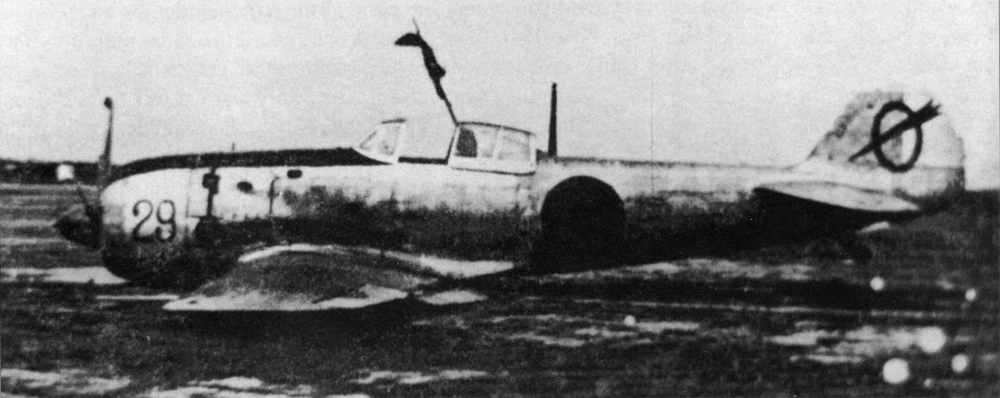
Our hero is known from a photograph taken after a forced landing in May 1945. The vast majority of descriptions mention that this particular aircraft was operated by a suicide unit. Frankly speaking, I have not come across any documents specifically confirming the fact. However, this does not prove anything, especially as there are a number of circumstances that appear to support such a thesis. These include the time and the place, the person of the pilot, and even (perhaps) the form of the emblem on the fighter’s tail.
Let me start off with the emblem. The insignia of 10. Rensei Hikotai was the number “10”, drawn using stylized Arabic numerals. Here, however, we see a different version of the symbol, namely the number “1” as an arrowhead piercing the “0”, which resembles a shield. Thus, while the original emblem was that of a training unit, this is clearly a combat insignia. The new graphic form began to appear some time in the spring of 1945, although I cannot say whether it was applied solely to kamikaze aircraft or also to those of the squadron’s combat instructor section.
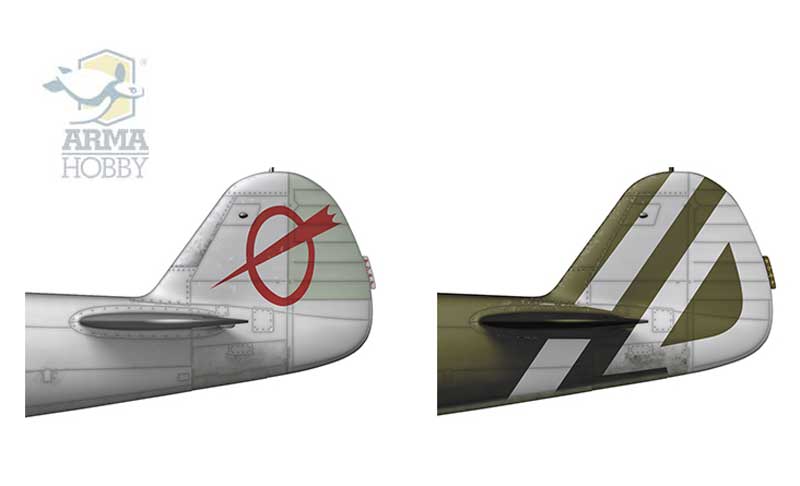
Two variants of the 10. Rensei Hikotai emblem
The unfortunate incident captured in the photograph occurred near Yura airfield on Awajishima (Awaji Island), most probably between 10 and 15 May 1945. The pilot of the aeroplane turned out to be Lieutenant Takata, an airman undergoing specialist training with 10. Rensei Hikotai. Shortly after completing the course in the spring of 1945, Takata and several other young officers from the unit applied for assignments to suicide squadrons. Their wishes were apparently granted, which comes as no surprise in light of the fierce battles that were raging for Okinawa at the time. In all likelihood, the forced landing took place while “Red 29” was being ferried to one of the airfields in the south of Kyushu. Awaji Island is located in the strait separating Honshu and Shikoku (south-west of the ports of Kobe and Osaka), and lies directly along the flight route from airports located near Tokyo to the bases on Kyushu which the Americans dubbed “Kamikaze nests”. Two different explanations have been given for the accident. Some sources state that the landing gear was broken during landing by an inexperienced pilot (an occurrence that was indeed a plague and the reason for a great many Hayate crashes), while others suggest a pancake landing necessitated by engine failure (which was also not uncommon). Personally, I am inclined to believe the latter. Looking at the photograph we can see that the wings are not excessively damaged, while the condition of the propeller seems to indicate that the engine was not running during touchdown; further, the landing took place before the aircraft even reached Yura airfield. Whatever the case may have been, the pilot escaped from the accident unscathed, and the fighter did not suffer heavy damage. Their further fates are unknown, however we may assume that, after a short repair, the “Red 29” and Lieutenant Takata continued on their journey towards their destination – Miyakonojo airfield on Kyushu.
Translation: Maciek Zakrzewski
See also:
Ki-84 Hayate – galeria premierowa – Wojtek Bułhak i Marcin Ciepierski
A lover of strong coffee and dark chocolate, incurable optimist, romantic and dreamer, economist by education, historian and modeller by passion. From time immemorial he has been fascinated with aviation in every variety and form. For many years, he has been paying special attention to all aspects of the activities of the Army and Navy Aviation of the Land of the Rising Sun.
This post is also available in:
 polski
polski




